Late Religious Paintings by Rubens
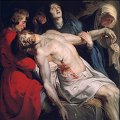 The Flemish and European
Baroque painter Peter Paul Rubens was the
most renowned northern European artist of his day, and is now widely
recognized as one of the foremost painters in Western art history. He
was the proponent of the Baroque style which emphasized
movement, color, and sensuality. By completing
the fusion of the realistic tradition of Flemish painting with the
imaginative freedom and classical themes of Italian Renaissance
painting, he fundamentally revitalized and redirected northern
European painting.
The Flemish and European
Baroque painter Peter Paul Rubens was the
most renowned northern European artist of his day, and is now widely
recognized as one of the foremost painters in Western art history. He
was the proponent of the Baroque style which emphasized
movement, color, and sensuality. By completing
the fusion of the realistic tradition of Flemish painting with the
imaginative freedom and classical themes of Italian Renaissance
painting, he fundamentally revitalized and redirected northern
European painting.
- The Martyrdom of St. Stephen (1617)
- Christ on the Cross between the Two Thieves (1620)
- Madonna in Floral Wreath (1620)
- The Fall of the Damned (1620)
- The Assumption of Mary (1622)
- The Adoration of the Magi (1624)
- Assumption of the Virgin (1626)
- Immaculate Conception (1628)
- St. Cecilia (1630)
- The Holy Family with St. Anne (1630)
- The Crowning of St. Catherine (1631)
- The Feast of Herod (1633)
- The Martyrdom of St. Livinus (1633)
- The Road to Calvary (1637)
The Martyrdom of St. Stephen (1617)
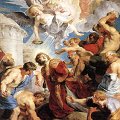 Get
Get  a high-quality picture of
The Martyrdom of St. Stephen for your computer or notebook. ‣
This painting, the centre panel of a triptych, was commissioned by the rich Benedictine Abbey Saint-Amand, near Valenciennes. In open state the triptych shows the martyrdom of St Stephen (centre) and scenes from the saint's life. When the wings are closed an Annunciation can be seen on the reverse of the side wings.
a high-quality picture of
The Martyrdom of St. Stephen for your computer or notebook. ‣
This painting, the centre panel of a triptych, was commissioned by the rich Benedictine Abbey Saint-Amand, near Valenciennes. In open state the triptych shows the martyrdom of St Stephen (centre) and scenes from the saint's life. When the wings are closed an Annunciation can be seen on the reverse of the side wings.
Christ on the Cross between the Two Thieves (1620)
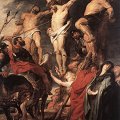 Get
Get  a high-quality picture of
Christ on the Cross between the Two Thieves for your computer or notebook. ‣
The painting is also called as Pierced with a Lance.
a high-quality picture of
Christ on the Cross between the Two Thieves for your computer or notebook. ‣
The painting is also called as Pierced with a Lance.
Rubens' close involvement with the resurgence of Catholicism and the struggle for power led to the production a numerous large altarpieces. His stirring Baroque ideas come to the fore in The Lance, with its emotionally charged, highly plastic figures.
Madonna in Floral Wreath (1620)
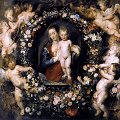 Get
Get  a high-quality picture of
Madonna in Floral Wreath for your computer or notebook. ‣
Religious flower still-lifes are a special category, first developed by the Fleming Daniel Seghers, a pupil of Jan Brueghel the Elder. However, this can be traced back to Rubens's Madonna in Floral Wreath (with the collaboration of Jan Brueghel the Elder). This represents a picture within a picture with an authoritative religious significance, encircled by a floral arrangement and cherubs. Unlike Seghers, however, Rubens did not quote Mary and Jesus as historical traditions or pictorial relics. Instead he preferred to give the impression that they were physically present, even though the motif of a picture within a picture would have been ideally suited for illusionist stylization.
a high-quality picture of
Madonna in Floral Wreath for your computer or notebook. ‣
Religious flower still-lifes are a special category, first developed by the Fleming Daniel Seghers, a pupil of Jan Brueghel the Elder. However, this can be traced back to Rubens's Madonna in Floral Wreath (with the collaboration of Jan Brueghel the Elder). This represents a picture within a picture with an authoritative religious significance, encircled by a floral arrangement and cherubs. Unlike Seghers, however, Rubens did not quote Mary and Jesus as historical traditions or pictorial relics. Instead he preferred to give the impression that they were physically present, even though the motif of a picture within a picture would have been ideally suited for illusionist stylization.
This painting is a good example of the encounter of talents of Rubens and Jan Brueghel the Elder, one much appreciated by collectors. Each exhibits his own virtuosity, Rubens painting the figures and Brueghel the floral decoration.
The Fall of the Damned (1620)
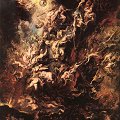 Get
Get  a high-quality picture of
The Fall of the Damned for your computer or notebook. ‣
In this painting, reminiscent of Tintoretto, the frightful moment of God's last judgment is depicted for a Counter-Reformation audience in an inimitable manner as a whirlwind, sucking down a jumble of the bodies of the damned.
a high-quality picture of
The Fall of the Damned for your computer or notebook. ‣
In this painting, reminiscent of Tintoretto, the frightful moment of God's last judgment is depicted for a Counter-Reformation audience in an inimitable manner as a whirlwind, sucking down a jumble of the bodies of the damned.
The Assumption of Mary (1622)
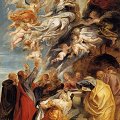 Get
Get  a high-quality picture of
The Assumption of Mary for your computer or notebook. ‣
On 12 November 1619 a contract was drawn up between Johannes del Rio, dean of the Onze-Lieve Vrouwekerk in Antwerp, and Peter Paul Rubens. The painter undertook to paint 'a panel depicting the story of the Assumption of Our Lady' for a fee of 1500 guilders. He received the first 1000 guilders in September 1626, and the remaining 500 guilders followed in March 1627.
a high-quality picture of
The Assumption of Mary for your computer or notebook. ‣
On 12 November 1619 a contract was drawn up between Johannes del Rio, dean of the Onze-Lieve Vrouwekerk in Antwerp, and Peter Paul Rubens. The painter undertook to paint 'a panel depicting the story of the Assumption of Our Lady' for a fee of 1500 guilders. He received the first 1000 guilders in September 1626, and the remaining 500 guilders followed in March 1627.
The reason for the long delay between the conclusion of the contract and the execution of the commission was that the altar where the painting was to be placed was not completed until 1626. The dimensions involved were gigantic: the altar is 14 metres high and more than 7 metres wide.
Rubens's altarpiece measures 4,9 by 3,25 metres. As a first step towards the making of this monumental composition, Rubens painted the 'modello' discussed here, which may be dated on stylistic grounds in the early 1620s. This preliminary study was intended to give the client an idea of what the composition would look like, so that he could comment on it at an early stage.
Preliminary studies of this kind by Rubens are best characterised as ideas expressed in paint. The rapid execution this implies is also clearly visible in the technique: the paint has been applied off the cuff in rapid movements of the brush. The upward movements give the image a highly dynamic quality. Although Rubens often enlisted assistants to help him with major commissions, it is clear from the high quality of this 'modello' and the altarpiece in the OnzeLieve-Vrouwekerk that he executed this important commission all by himself.
The Adoration of the Magi (1624)
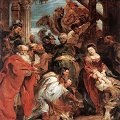 Get
Get  a high-quality picture of
The Adoration of the Magi for your computer or notebook. ‣
Rubens' close involvement with the resurgence of Catholicism and the struggle for power led to the production a numerous large altarpieces. His stirring Baroque ideas come to the fore in The Lance (1619-20), with its emotionally charged, highly plastic figures, and The Adoration of the Magi (1624). This masterpiece is particularly impressive because of its animated, asymmetrical composition, its marvelously gradated colouring, the spontaneity of execution and, above all, the expressiveness of the depicted figures.
a high-quality picture of
The Adoration of the Magi for your computer or notebook. ‣
Rubens' close involvement with the resurgence of Catholicism and the struggle for power led to the production a numerous large altarpieces. His stirring Baroque ideas come to the fore in The Lance (1619-20), with its emotionally charged, highly plastic figures, and The Adoration of the Magi (1624). This masterpiece is particularly impressive because of its animated, asymmetrical composition, its marvelously gradated colouring, the spontaneity of execution and, above all, the expressiveness of the depicted figures.
Assumption of the Virgin (1626)
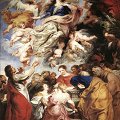 Get
Get  a high-quality picture of
Assumption of the Virgin for your computer or notebook. ‣
The Antwerp Cathedral was given a new marble high altar during the Baroque refurbishment that reached a peak around the beginning of the 17th century. Rubens, by then the most famous artist of his day, was commissioned to paint an altarpiece.
a high-quality picture of
Assumption of the Virgin for your computer or notebook. ‣
The Antwerp Cathedral was given a new marble high altar during the Baroque refurbishment that reached a peak around the beginning of the 17th century. Rubens, by then the most famous artist of his day, was commissioned to paint an altarpiece.
The image of the Assumption of the Virgin does not derive from the Bible but from an ecclesiastical tradition that took shape in the Middle Ages. By the 16th century, it had become a popular theme. The depiction of the Virgin, with her fluttering robe and swirling head-dress, is graceful and lively. She is borne up to heaven in a cloud by playful putti. Two angels at the top left of the painting are about to crown her with a garland of roses. The twelve apostles stand around her sarcophagus at the bottom. The three women who, according to legend, laid out the Virgin's body are also included. The attractive woman in the middle, wearing a red dress, is given greater prominence than the other bystanders. Her features are those of Rubens' wife, Isabella Brant, who died in June 1626, while the artist was working on this painting.
Immaculate Conception (1628)
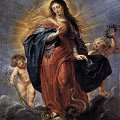 Get
Get  a high-quality picture of
Immaculate Conception for your computer or notebook. ‣
King Philip IV's affection for pictures was emulated by his courtiers who amassed large collections and helped to turn Madrid into one of the most active picture market in Europe. Diego Messia, the marquis of Leganes's beginnings as a collector was modest enough; in 1630, his inventory lists a mere eighteen works, eleven of which were ascribed to Titian. Twelve years later, the total increased to well over 1.100 pictures, among them masterpieces by Rubens and van Dyck, as well as a generous share by lesser Flemish masters. Leganes also collected the Flemish primitives. His Italian paintings included attributions to Titian, Raphael, Veronese and the Bassanos.
a high-quality picture of
Immaculate Conception for your computer or notebook. ‣
King Philip IV's affection for pictures was emulated by his courtiers who amassed large collections and helped to turn Madrid into one of the most active picture market in Europe. Diego Messia, the marquis of Leganes's beginnings as a collector was modest enough; in 1630, his inventory lists a mere eighteen works, eleven of which were ascribed to Titian. Twelve years later, the total increased to well over 1.100 pictures, among them masterpieces by Rubens and van Dyck, as well as a generous share by lesser Flemish masters. Leganes also collected the Flemish primitives. His Italian paintings included attributions to Titian, Raphael, Veronese and the Bassanos.
This Immaculate Conception by Rubens was also part of Leganes's collection.
St. Cecilia (1630)
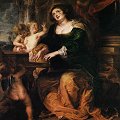 Get
Get  a high-quality picture of
St. Cecilia for your computer or notebook. ‣
In this composition, the only large-scale work on this subject by Rubens, he portrays the saint, who is revered as the patron of music, playing a spinet at the foot of a formal, architectural vista of pillars. Beyond the terrace-like room stretches an expanse of Flemish landscape, yet the presence of the angels emphasizes the sublime character of the scene. As her ringers touch the keys of her instrument, the saint is entranced by celestial music and in her face is reflected the heavenly paradise towards which she gazes, wide-eyed.
a high-quality picture of
St. Cecilia for your computer or notebook. ‣
In this composition, the only large-scale work on this subject by Rubens, he portrays the saint, who is revered as the patron of music, playing a spinet at the foot of a formal, architectural vista of pillars. Beyond the terrace-like room stretches an expanse of Flemish landscape, yet the presence of the angels emphasizes the sublime character of the scene. As her ringers touch the keys of her instrument, the saint is entranced by celestial music and in her face is reflected the heavenly paradise towards which she gazes, wide-eyed.
The Berlin Saint Cecilia is one of the last pictures which Rubens painted, apart from official commissions towards the end of his life. As in so many pictures during this later period, Helene Fourment, who had become his second wife in 1630, served as the artist's model. The bold and rapid application of colour is vivacious and rich in delicate nuances: deep emerald green appears side by side with dark red and brilliant yellow, emphasizing the pale, enamel-like flesh-tones. There are many corrections to the painted surface which show that Rubens altered considerable portions of the picture while working on it, and even enlarged the panel on the left-hand side.
The formal interpretation in the composition in no way detracts from the human, almost intimate, touches which Rubens has employed in depicting the saint. The casually worn cloak, the foot withdrawn from the shoe, the sleeping dog, and, last but not least, the features of Helene Fourment are all products of highly personal experience. The painter transforms the youthful body of his model into a monumental figure which combines, in a most moving way, portrait and sacred image.
This painting, which was found in Rubens' house following his death (1640), was presented the following year by his family to Jakob van Ophem in Brussels as a token of their gratitude for the help he had given in administering the artist's estate. Later it found its way to Paris, where the young Watteau saw it and made a crayon drawing of it.
The Holy Family with St. Anne (1630)
 Get
Get  a high-quality picture of
The Holy Family with St. Anne for your computer or notebook. ‣
Although Rubens run a large workshop, he was perfectly honest about his proceedings. Studio works were rigorously distinguished from those to which he had, to a greater or lesser extent, contributed. Philip IV of Spain wanted works by Rubens, and he wanted them in quantity; Rubens himself supplied them, and no assistants were permitted to help him. The Holy Family with St. Anne shows how tender the master's own hand could be in representing the warmth of family life.
a high-quality picture of
The Holy Family with St. Anne for your computer or notebook. ‣
Although Rubens run a large workshop, he was perfectly honest about his proceedings. Studio works were rigorously distinguished from those to which he had, to a greater or lesser extent, contributed. Philip IV of Spain wanted works by Rubens, and he wanted them in quantity; Rubens himself supplied them, and no assistants were permitted to help him. The Holy Family with St. Anne shows how tender the master's own hand could be in representing the warmth of family life.
The Crowning of St. Catherine (1631)
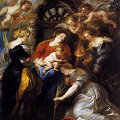 Get
Get  a high-quality picture of
The Crowning of St. Catherine for your computer or notebook. ‣
In his religious paintings Rubens tried to stir the viewer's emotions. Pictures with a theme of Catholic dogma intended as propaganda loose something of their emphasis in favour of an unmistakable lyricism, clearly illustrated by the Crowning of St Catherine.
a high-quality picture of
The Crowning of St. Catherine for your computer or notebook. ‣
In his religious paintings Rubens tried to stir the viewer's emotions. Pictures with a theme of Catholic dogma intended as propaganda loose something of their emphasis in favour of an unmistakable lyricism, clearly illustrated by the Crowning of St Catherine.
The Feast of Herod (1633)
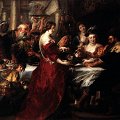 Get
Get  a high-quality picture of
The Feast of Herod for your computer or notebook. ‣
The biblical source for the painting is Matthew 14:6-11 or Mark 6:21-8, where the daughter of Herodias danced for her stepfather, Herod, on his birthday. As a reward he promised her anything she wanted and, prompted by her mother, she chose the head of Saint John the Baptist, which she then carried to Herodias on a silver charger. The daughter subsequently became known in literature as Salome, and the theme was memorably treated in the nineteenth century by Richard Strauss and Oscar Wilde amongst others.
a high-quality picture of
The Feast of Herod for your computer or notebook. ‣
The biblical source for the painting is Matthew 14:6-11 or Mark 6:21-8, where the daughter of Herodias danced for her stepfather, Herod, on his birthday. As a reward he promised her anything she wanted and, prompted by her mother, she chose the head of Saint John the Baptist, which she then carried to Herodias on a silver charger. The daughter subsequently became known in literature as Salome, and the theme was memorably treated in the nineteenth century by Richard Strauss and Oscar Wilde amongst others.
The Martyrdom of St. Livinus (1633)
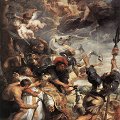 Get
Get  a high-quality picture of
The Martyrdom of St. Livinus for your computer or notebook. ‣
This monumental canvas once decorated the high altar of the Jesuit church in Ghent. When the order was dissolved at the end of the 18th century, Louis XVI bought the painting which, after the French Revolution, ended up in the Brussels museum.
a high-quality picture of
The Martyrdom of St. Livinus for your computer or notebook. ‣
This monumental canvas once decorated the high altar of the Jesuit church in Ghent. When the order was dissolved at the end of the 18th century, Louis XVI bought the painting which, after the French Revolution, ended up in the Brussels museum.
According to the legend, the Scots monk Livinus was not only bishop of Ghent but also a martyr whose tongue was torn out. It is possible that Rubens was commissioned to produce this painting for the millennium of the martyrdom in 1633. In so doing a date previously assumed for Livinus' martyrdom was corrected and the exemplary behaviour of a local saint, the founder of the local community of believers, was given place of honour in the church. All this is typical of the Jesuit's counter-reformation intentions of basing the re-sourcing of the true faith on militant, recognisable and historically grounded foundations. Their founder, Ignatius of Loyola, defended the heroism of the martyrs against the Protestants.
In the prints of Meditations on the Gospel, a book of devotions written by the Jesuit Hieronymus Nadal on Ignatius' instructions, the accent is therefore on the cruelty of their tortures. Rubens' depiction of Livinus' torture follows the same line. The viewer is spared not a single horrible detail, neither the blood-spattered knife in the torturer's mouth who in the left foreground grins at the saint in his bishops' garments with his mitre and staff, nor his companion who has grabbed Livinus' beard, nor his comrade-in-arms holding the saint's torn-out tongue in a pair of tongs above an avidly yapping dog. The strong gestures, the rhythm of the paint strokes, the shimmering lighting and the masterly colour composition carry the sense of movement to a climax. From heaven comes the reward for the martyr and the justified retribution for his executioners' misdeed, in the figures of two putti, who reach Livinus the martyr's palm, and the angels who, with their thunderbolts, cause the soldiery to disperse in fear and their horses to bolt. For this final, central detail, Rubens took his inspiration from the famous Tyrant Slayers group of statues in front of the Quirinale Palace in Rome, thereby playing to the learned Jesuits' love for surprising aesthetic effects and their erudite knowledge of antiquity.
The Road to Calvary (1637)
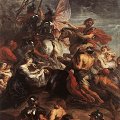 Get
Get  a high-quality picture of
The Road to Calvary for your computer or notebook. ‣
This painting was commissioned in 1634 for the high altar of the Abbey of Affligem, then one of the most important monasteries in the Low Countries. Tensions inside the monastery may explain why this monumental work was not delivered until 1637.
a high-quality picture of
The Road to Calvary for your computer or notebook. ‣
This painting was commissioned in 1634 for the high altar of the Abbey of Affligem, then one of the most important monasteries in the Low Countries. Tensions inside the monastery may explain why this monumental work was not delivered until 1637.
In this production of his mature period, Rubens masterfully combines two artistic traditions. The first of these is that of the large single-frame altarpieces that were to replace the older polyptychs in the Southern Low Countries in the 17th century. With their exceptional scale and their strongly vertical format, they faced artists with the problem of constructing a convincing compositional unity from a series of related themes in a vertical format. As an artist gifted with one of the greatest compositional and narrative talents of his age, Rubens fulfilled his task masterfully. Instead of dividing the painting into an upper and lower register, a solution that he had often applied following Titian, he elects here to represent Christ's ascension to the place of his execution on Calvary in an uninterrupted zigzag movement. The thrust from below to above is achieved both in the colouring, with a balanced rhythm of localised concentrations of colour, and also iconographically, with the successive tableaux of the executioners with the two thieves, the holy women with Mary and Veronica, and ending with the Roman officers on horseback with their flapping pennants.
The centre-point of the composition is Christ's face that St Veronica is wiping. Turned towards the viewer, it forms a direct call to the faithful to follow his life and to think on their own sins that had to be redeemed by Christ's suffering. This procedure descends directly from the tradition of devotional art, with small-scale pictures intended for individual meditation. The genius of Rubens' invention lies precisely in the combination of the two pictorial traditions, breathing new life into the ancient devotional tradition within a contemporary, counter-reformation form of altar decoration, whilst at the same time enriching the broad, sweeping movement of such a monumental high altarpiece with the more intimate emotionality of smaller devotional paintings.
Peter Paul Rubens Art
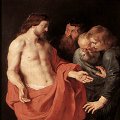
|
|
More
Articles
 Art Encyclopedia A world history of art in articles.
Art Encyclopedia A world history of art in articles.
Baroque
Peter Paul Rubens
Art and life. Biography.
Early mythological paintings.
Late mythological paintings.
Early religious paintings.
Late religious paintings.
Portraits.
Landscapes.
Art
 Art Wallpapers Art image collections for your desktop.
Art Wallpapers Art image collections for your desktop.
Caravaggio Art, $25
(100 pictures)
Rubens Art, $29
(200 pictures)
Rembrandt Art, $25
(160 pictures)

